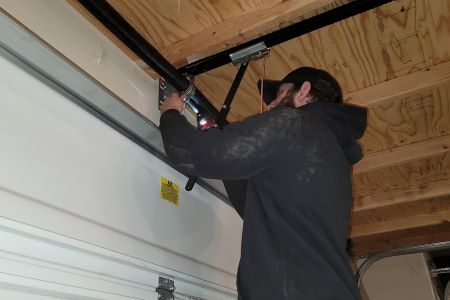Usual Garage Door Troubles and How to Take care of Them
Garage doors are necessary for both protection and convenience, yet they typically offer a range of common issues that can frustrate property owners. Troubles such as too much sound throughout procedure, doors that fall short to open up or close, misaligned tracks, and malfunctioning remotes can occur without warning. While some issues may appear straightforward to fix, others may call for a more nuanced understanding of garage door technicians. Dealing with these troubles properly not only improves performance yet additionally lengthens the life of the door. One could question what actions are necessary to take on these obstacles successfully.
Noisy Garage Door Procedure
A noisy garage door procedure can be a considerable source of aggravation for house owners, often suggesting underlying mechanical concerns. Such disruptions might originate from numerous causes, including worn-out rollers, loosened hardware, or not enough lubrication. Determining the resource of the noise is crucial for efficient resolution.
Over time, these components can deteriorate, leading to grinding or squeaking noises as the door moves. Additionally, loosened screws or screws in the door device can produce rattling sounds during procedure.
An additional adding factor is inadequate lubrication of the door's moving components. Using a high-quality lubricant to the tracks, springtimes, and rollers can substantially reduce friction and sound. Home owners should do this maintenance periodically to maintain ideal performance.
Finally, the garage door opener may also create noise because of its age or mechanical concerns. If the sound continues in spite of dealing with various other elements, speaking with an expert for a comprehensive evaluation and potential fixing may be essential.
Door Will Not Open or Shut
Experiencing a garage door that won't open or close can be exceptionally irritating and often indicates a breakdown within the system. Several elements can add to this problem, and determining the origin cause is essential for effective resolution.

Following, examine the safety sensing units located at the base of the door. These sensors can end up being misaligned or blocked by particles, stopping the door from running correctly. Clean the sensing units with a soft cloth and ensure they are lined up.
Additionally, the garage door's inner elements must be reviewed. Concerns such as a broken springtime, worn-out rollers, or a harmed opener can hamper motion. If any type of elements seem damaged, it might be a good idea to speak with an expert for repair services.
Misaligned Tracks
(Premium Service)Misaligned tracks can severely interfere with the smooth operation of a garage door, causing functional failings such as uneven activity or full immobilization. This concern usually emerges as a result of a range of variables, consisting of damage, unexpected effects, or inappropriate installment. When the tracks are misaligned, the rollers can stagnate easily, which not only strains the motor but also poses safety and security risks.
If you notice any type of inconsistencies, it is vital to deal with the concern without delay. Thoroughly touch the track back right into its correct placement using a rubber mallet or a similar tool, guaranteeing it is straight and level.
Routine maintenance, consisting of cleaning the tracks and making certain rollers are in excellent condition, can avoid future imbalances. By attending to misaligned tracks immediately, you can restore the capability of your garage door and enhance its durability.
Broken Springs
Among the different elements of a garage door system, broken springs are among one of the most usual issues that can considerably hamper its functionality. Garage door springs are vital for balancing the weight of the door, permitting for smooth opening and closing. When a springtime breaks, it can bring about a door that is challenging to run or, sometimes, totally inoperable.
There are 2 main kinds of springs: torsion springtimes, which are placed over the door, and extension springtimes, found on either side. Indicators of a damaged spring consist of a door that won't open, a visible space in the spring, or a loud sound throughout operation. Attempting to operate a garage door with a broken spring can trigger further damage to the door or the opener.
Fixing broken springs is not a do it yourself task; it needs specialized tools and knowledge because of the high stress entailed. It is recommended to consult a specialist technician that can safely change the springtimes and make sure the door is correctly stabilized. Normal maintenance and examinations can help prevent spring failings and prolong the life expectancy of the garage door system.
Push-button Control Issues

The very first step is to examine the batteries in the remote. Change them if they are weak or dead. If the remote still falls short to operate, inspect the garage door opener to make certain that its sensing units are clean and unhampered. Dirt, debris, or misalignment might impede the signal transmission in between the remote and the opener.
Disturbance from various other electronic devices can also restrain remote capability. Make sure that close-by devices, such as cordless routers or cordless phones, are not triggering interruptions. garage door service. If interference is believed, attempt moving these tools additionally away from the garage door opener
In some cases, the remote might need to be reprogrammed. Speak with the manufacturer's standards to reset the push-button control and synchronize it with the garage door opener. If all else falls short and the remote remains to malfunction, consider consulting a professional service technician for a detailed examination and prospective substitute of the remote or opener.
Final Thought
(Clear Communication)In summary, typical garage door troubles can considerably influence functionality and security. Resolving noisy operation entails lubrication and tightening up hardware, while problems with opening or closing call for examination of source of power and sensors. Misaligned tracks can be treated through modification, although damaged springtimes necessitate expert treatment. Remote malfunctions normally arise from weak batteries or interference, which can be solved via replacement or reprogramming. Aggressive maintenance and timely fixings can ensure ideal efficiency and long life of garage doors.